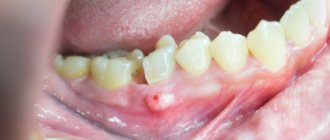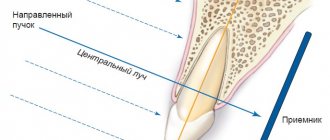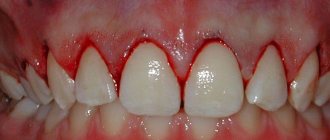What is it and why does it happen
This disease is a local acute inflammatory process in the oral cavity, which is characterized by the accumulation of pus in the tissues of the gums, teeth or palate. Lack of timely and correct treatment can lead to a transition to a chronic form or cause such serious complications as the appearance of phlegmon or sepsis.
The causes of this disease are the presence of problems with the gums (gingivitis), with the roots of the teeth and adjacent tissues (periodontitis), with the enamel and hard surface (caries), as well as various mechanical injuries, infection, and chronic diseases. People suffering from diabetes and immune diseases are at increased risk of becoming acquainted with this unpleasant disease.
If your tooth is cracked, the roots are exposed, deep cavities appear, do not wait for an abscess to develop - be sure to visit the doctor at our dental clinic in Lyublino, because untreated caries is the main reason for the development of the inflammatory process.
In our clinic you can get a free dental consultation!
Types of paratonsillar abscesses
Depending on the location of the abscess in the peritonsillar tissue, there are:
- Anterior superior abscess (pus accumulates behind the anterior arch and soft palate near the upper pole of the tonsil) - most often.
- External or lateral abscess (accumulation of pus between the tonsil capsule and the pharyngeal fascia).
- Posterior abscess (accumulation of pus in the area of the posterior arch) - the phenomenon of trismus is completely absent. It is this abscess that is potentially dangerous for the development of laryngeal edema, followed by acute stenosis of this organ.
- Lower abscess (the anterior palatal arch is displaced downward and anteriorly due to infiltration of the lower section).
The anterosuperior abscess is characterized by hyperemia, infiltration, and swelling of the supratonsillar space. The tonsil on the affected side is slightly changed, covered and pushed down and anteriorly by the infiltrated anterior palatine arch.
Posterior peritonsillar abscess is less common. It is characterized by significant swelling and infiltration of the posterior palatine arch. Swelling can spread to the vestibular part of the larynx and soft palate. The tonsil on the affected side is displaced anteriorly. The complaints are dominated by pain in the throat when swallowing, but trismus of the masticatory muscles is absent.
Lateral paratonsillar abscess (external) is characterized by tissue infiltration in the area of the lateral surface of the neck with the presence of cervical lymphadenitis, pain on palpation in the submandibular region, trismus of the masticatory muscles, bulging of the tonsil to the midline of the oropharynx, and the presence of moderate infiltration of the entire paratonsillar tissue.
Inferior peritonsillar abscess is rare. The anterior palatal arch is displaced downward and anteriorly due to infiltration of the lower part. Patients complain of severe pain when swallowing, intensifying when opening the mouth, with irradiation into the ear on the affected side. In some cases, the swelling shifts to the lingual surface of the epiglottis
Clinical and morphological forms:
- edematous,
- infiltrative,
- abscessing.
Our doctors
18 years of experience
Baghdasaryan
Armen Evgenievich
Chief physician, dentist-orthopedist-therapist
Graduated from VSMA named after. N.N. Burdenko. Internship on the basis of MGMSU named after. A.E. Evdokimov in “General Dentistry”.
Clinical residency at the Moscow State Medical University named after. A.E. Evdokimov in “Orthopedics”.
More about the doctor...
5 years experience
Sadina
Ekaterina Vladislavovna
Dental therapist, surgeon
Penza State University Medical Institute, specialty “Dentistry”.
In 2016, she underwent professional retraining in the specialty “Therapeutic Dentistry” at the Moscow State Medical and Dental University named after A.I. Evdokimov.
More about the doctor...
8 years of experience
Arzumanov
Andranik Arkadievich
Dentist-orthodontist
Graduated from Moscow State Medical University. Internship - Moscow State Medical University at the Department of Orthodontics and Children's Prosthetics.
Residency at Moscow State Medical University at the Department of Orthodontics and Children's Prosthetics. Member of the Professional Society of Orthodontists of Russia since 2010.
More about the doctor...
Cost of treating peritonsillar abscess
The prices indicated in the price list may differ from the actual prices. Please check the current cost by calling +7 495 104 8605 (24 hours a day) or at the GMS Hospital clinic at the address: Moscow, st. Kalanchevskaya, 45.
| Name | Price |
| Opening of the epiglottis abscess | RUB 54,999 |
| Opening abscesses, phlegmon of the laryngopharynx | RUB 64,995 |
| Opening a paratonsillar or retropharyngeal abscess | RUB 46,998 |
| Drainage of peritonsillar abscess | RUB 24,997 |
| Tonsillectomy + removal of peritonsillar abscess (According to Quinzey) | RUB 189,994 |
Dear Clients! Each case is individual and the final cost of your treatment can only be found out after an in-person visit to a GMS Hospital doctor. Prices for the most popular services are indicated with a 30% discount, which is valid when paying in cash or by credit card. You can be served under a VHI policy, pay separately for each visit, sign an agreement for an annual medical program, or make a deposit and receive services at a discount. On weekends and holidays, the clinic reserves the right to charge additional payments according to the current price list. Services are provided on the basis of a concluded contract.
Plastic cards MasterCard, VISA, Maestro, MIR are accepted for payment. Contactless payment with Apple Pay, Google Pay and Android Pay cards is also available.
Western standards of treatment (evidence-based medicine)
Continuous staff development
Regular interaction with leading Russian and foreign medical institutions
Modern medical equipment and advanced diagnostic and treatment methods
Unified standard of service
We work around the clock 24/7/365
Make an appointment We will be happy to answer any questions Coordinator Oksana
Symptoms
The main symptoms of this disease are:
- An increase in acute, throbbing or aching toothache, intensifying with food intake;
- Experiencing a bitter taste or unpleasant odor in the mouth;
- Feeling of general weakness, headache, apathy, insomnia, lack of appetite;
- Increased tooth sensitivity;
- The gums become inflamed, there is swelling, redness, a small compaction or swelling filled with pus is formed;
- There is an enlargement of the cervical lymph nodes;
- As the infection develops, nausea appears and body temperature rises;
- Facial asymmetry may appear, the size of one cheek, lower or upper lip may increase.
It is important to know that an abscess that begins on one tooth, if left untreated, can spread to the next. If the outer shell cannot withstand and ruptures, the pus comes out, it becomes easier and the pain goes away, but there is a risk of purulent masses getting into healthy tissues and teeth, and the sad story repeating. Ignoring purulent seals in the oral cavity can lead to such dire consequences: tooth loss, death of jaw tissue, development of respiratory diseases (pneumonia, sore throat) and vision. This is also fraught with paralysis of the facial nerves, and the entire body is exposed to acute intoxication.
Symptoms of phlegmonous sore throat
The disease begins acutely with the appearance of pain when swallowing, most often on one side (a one-sided abscess is 100 times more likely than a two-sided one). Typically, a peritonsillar abscess occurs after a sore throat during the recovery period. When examining the pharynx, there is a sharp swelling and hyperemia (redness) of the tissues around the tonsil (arches, soft palate, uvula), protrusion of the tonsil from the niche, and a shift to the midline. An abscess forms on average about two days. General symptoms: weakness, fever, enlarged cervical lymph nodes on the side of the abscess.
The classic triad of peritonsillar abscess was noted:
- Profuse drooling.
- Trismus of the masticatory muscles (difficulty or inability to fully open the mouth).
- Open nasal sound (as a result of paralysis of the muscles of the velum).
What types are there
Depending on the location of the source of inflammation in the oral cavity, abscesses can be localized to:
- Gums One of the most common types, it forms around the inflamed soft tissues of a certain tooth, without proper treatment it becomes chronic. During an exacerbation, bad breath appears, accompanied by the discharge of pus and general weakness;
- Palate Usually occurs with periodontitis located in the teeth of the upper jaw, quickly spreads to other tissues, and can cause the development of osteomyelitis (bone necrosis);
- Cheeks A very dangerous type of inflammation, if left untreated there is a risk of inflammation spreading to the skin of the face. It affects the inside, and it is possible that the outside of the cheek can also be affected. A possible reason for the appearance is infection in the smallest wounds when biting the mucous membrane with teeth.
- Floor of the mouth Placed under the tongue, characterized by severe pain when eating or talking. An abscess that spontaneously opens can further spread the infection through the throat to other organs of the body;
- On the tongue, the surface thickens and swells. There is redness, it hurts to eat, talk and even just breathe. This type of inflammation causes a feeling of suffocation and lack of air, and therefore requires urgent hospitalization.
Abscess of the palate
Another type of inflammation in the oral cavity is a palatal abscess. Most often it is a consequence of periodontitis of the maxillary teeth (premolars, canines and incisors). This type of inflammation begins with redness and pain in the area of the hard palate. As the focus of inflammation increases, the pain intensifies, making it difficult to chew food. If the abscess spontaneously opens, the risk of infection spreading to the entire area of the hard palate increases, as well as the development of osteomyelitis.
Based on the site of formation, this type of tumor can be divided into two subtypes: inflammation of the hard palate and soft palate:
Abscess of the hard palate
- the patient complains of a noticeable throbbing pain in the palate (upper jaw), which intensifies when talking and trying to chew food;
- foci of infection - periodontal pockets of the maxillary teeth, wounds on the mucous membrane of the hard palate;
- may spread in the absence of timely treatment to the soft palate and peripharyngeal space.
Abscess of the soft palate
- complaints of painful swallowing, sore throat, aggravated by talking. The affected area greatly increases in size;
- sources of infection - damaged lacunae of the tonsils in chronic tonsillitis, microcracks in the mucous membrane of the soft palate, places where local anesthesia was administered;
- further spread leads to damage to the peritonsillar and peripharyngeal space.
When faced with the problems described above, it is important to remember that timely consultation with a doctor will not only keep you healthy, but will also allow you to avoid a lot of complications.
Treatment
To get a complete picture of the disease, dentists use modern diagnostic methods, on the basis of which they select the optimal solution to this problem. These include radiography, ultrasound, sampling of purulent mass and their analysis, visual examination of the condition of the pharynx (pharyngoscopy). Based on the results obtained and studying the history of the disease, appropriate therapy will be prescribed.
Before visiting a doctor, you can alleviate your condition a little by taking painkillers and warm antiseptic solutions, but you should not put off visiting the dentist for long, because the process develops very quickly and does not go away on its own.
Treatment of an oral abscess is usually carried out using two methods:
- Surgical intervention Allows you to avoid most of the complications that may arise from an unauthorized breakthrough of a purulent sac. The operation is performed under local anesthesia by a dental surgeon, with the help of special instruments the abscess is opened, the wound is cleaned and drainage is placed, after the operation antibiotics, antihistamines, vitamins and immunomodulators are prescribed;
- Medication Medications (Fluocinonide gel, Chlorhexidine solution, Ibuprofen) are prescribed only in the initial stage; timely consultation with a doctor and timely prescribed medications help avoid surgical intervention.
When the pus comes out, relief comes: there is no more pain, the temperature returns to normal, and the swelling disappears. The course of treatment ends with the necessary physical procedures: electropharesis with the addition of an antiseptic on the gums, UHF heating, and the procedure for silvering teeth affected by caries. Until the wound in the mouth completely heals, the patient must abandon hard vegetables and fruits in favor of soft cereals and liquid soups.
Symptoms of paratonsillar abscess
Patients complain of the following symptoms:
- sharp pain in the throat. Most often it occurs on one side. Initially, discomfort manifests itself when swallowing, but as the pathology progresses, it is felt constantly. Afterwards the pain radiates to the lower jaw, to the ear;
- temperature increase. With inflammation it can rise to 38.0-38.5° C;
- general malaise, myalgia;
- profuse drooling;
- enlarged cervical lymph nodes under the jaw, in front and behind the neck;
- bad breath;
- dripping of saliva from the corners of the mouth. The symptom is caused by reflex hypersalivation.
It is important not to ignore the symptoms. As purulent processes progress, a tonic spasm of the masticatory muscles occurs—trismus, in which it is difficult or impossible to fully open the mouth. It is accompanied by nasality and changes in speech. When swallowed, food can enter the larynx and nasopharynx. It is painful for the patient to turn his head.
Prevention
In general, the effectiveness of treatment depends on at what stage of the disease the patient sought medical help and his general health. It is very important to follow all doctor’s orders and treatment procedures immediately after they are prescribed. A timely surgical operation and the absence of complications after it are a guarantee of healing the abscess within one to two weeks.
Preventive measures to prevent this disease are very simple:
- Maintain hygiene, which includes high-quality and proper care of teeth and gums (brushing teeth and tongue at least twice a day, cleaning interdental spaces with dental floss after meals, regular use of mouth rinses);
- Treat carious teeth and other oral diseases in a timely manner;
- Protect the jaws and oral mucosa from injury;
- Have a complete diet, including vitamins and vital microelements.
Simple tips, the implementation of which depends only on your desire, will help in the future to avoid serious consequences caused by an abscess. And remember: oral health directly affects the beauty and charm of your smile.
Treatment of peritonsillar abscess
- Conservative therapy. You will be prescribed antibiotics based on sensitivity to pathogens. To improve well-being, symptomatic therapy with antipyretic, anti-inflammatory, and analgesic drugs is indicated. The doctor may also administer infusion therapy. Rinsing the mouth with antiseptic agents is often indicated. Important! All medications and their dosage are selected by the doctor individually.
- Operative therapy. Opening a paratonsillar abscess is required for an abscess in the throat. At the same time, the doctor drains the cavity. With frequent relapses of the pathology, an abscessonsillectomy may be required - an operation to remove the involved tonsil.
Removal of paratonsillar abscess
It takes place on an outpatient basis at the Promedica clinic. Initially, you will be asked to sit in a chair and tilt your head back. The doctor acts in stages:
- antiseptic treatment of the working area;
- local anesthesia. Required to minimize discomfort. Pain relief is carried out by injecting an analgesic with a thin insulin syringe. In some clinical cases, an application with an anesthetic solution is carried out;
- opening a paratonsillar abscess with a scalpel. The dissection is carried out in the most convex place. Afterwards, the cavity is expanded with a clamp, the exudate is drained and the tonsils are thoroughly treated with an antiseptic.
Doctors with extensive clinical experience work with each patient. They act carefully, using only disposable consumables and sterile instruments. This minimizes the risk of complications.
Prices for the procedure
| Name of service | Price |
| opening of paratonsillar abscess | 750 |











